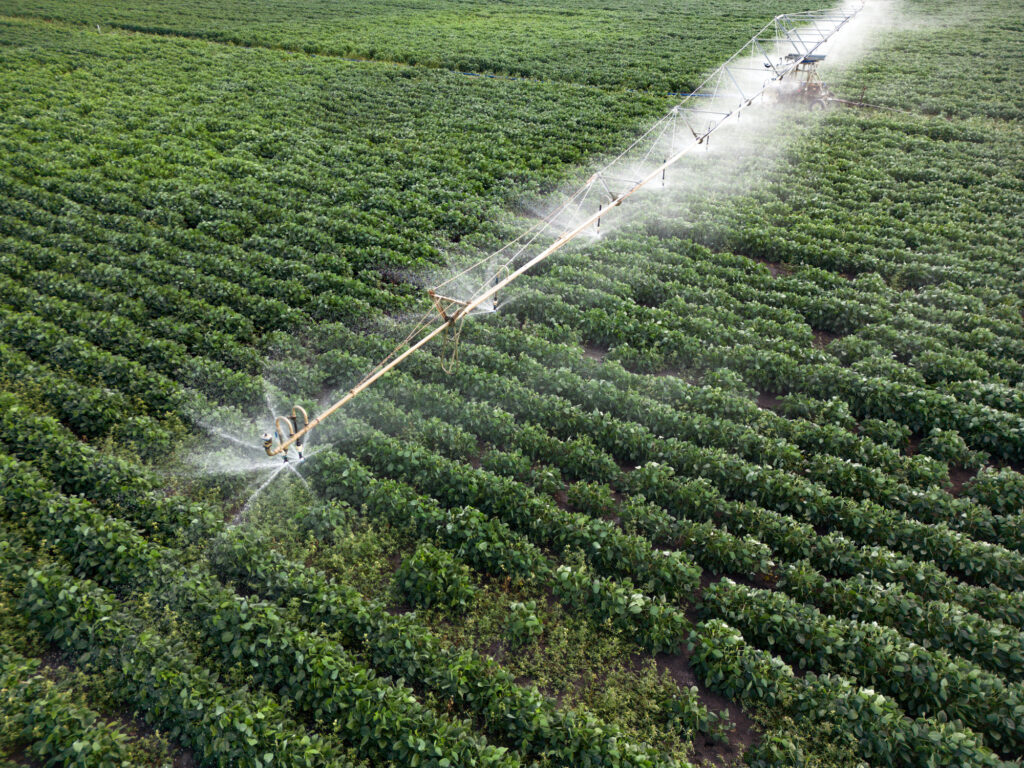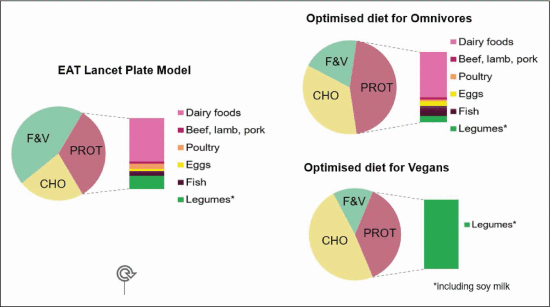 iStock/Thurtell
iStock/Thurtell Liselotte Schäfer Elinder and Patricia Eustachio Colombo
Food security is of vital importance for human existence. Yet, global food production has huge environmental impacts which increasingly threaten food security. Today, food production occupies around 40% of all ice-free land surface, contributes about 25% of all human-induced greenhouse gas emissions, and is the largest driver of deforestation. Moreover, it accounts for about 70% of the Earth’s freshwater withdrawals and is driving nitrogen and phosphorus eutrophication and acidification of the Earth’s ecosystems.
Current food system is not sustainable
The impacts of the production of food eaten by the Swedish population today are transgressing several of these planetary boundaries [1]. We exceed the rate of extinction of species about five to six times, meaning a large loss of biodiversity due to food production. When it comes to greenhouse gas emissions, we are about three times above the acceptable level. When it comes to cropland use, we are at double the recommended level, and for nitrogen and phosphorus application, we are five times over the limit in Sweden. Only water use is still within the planetary boundaries.
Today, food production occupies around 40% of all ice-free land surface, contributes about 25% of all human-induced greenhouse gas emissions, and is the largest driver of deforestation.
This development simply cannot continue, especially not with a growing population globally, which will worsen this situation. The food system is vital for health but at the same time, the environmental consequences threaten the achievement of several of the UN Sustainable Development Goals such as Goal 2: End hunger, achieve food security and improved nutrition, and promote sustainable agriculture and Goal 3: Ensure healthy lives and promote well-being for all at all ages.
Two billion people are currently nutrient-deficient, 700 million are severely food-insecure, and 135 million suffer from acute hunger today [2]. At the same time, an unhealthy diet accounts for just over 40% of all deaths from noncommunicable diseases globally. Today, 13% of the world’s population is obese, and 39% are overweight. Taken together, we see huge negative environmental and health impacts of the way we currently produce and consume food as well as an inequitable distribution of food globally.
We see huge negative environmental and health impacts of the way we currently produce and consume food as well as an inequitable distribution of food globally.
In January 2019, one year before the COVID-19 pandemic broke out, the medical journal The Lancet published a report called Food in the Anthropocene [3], written by the EAT Lancet Commission called Healthy diets from sustainable food systems. The message from the report was the following:
“Without action, the world risks failing to meet the UN Sustainable Development Goals (SDGs) and the Paris Agreement, and today’s children will inherit a planet that has been severely degraded and where much of the population will increasingly suffer from malnutrition and preventable disease.”
In this report, the authors had designed a healthy and environmentally sustainable mainly plant-based plate model where half of the plate contains vegetables and fruit, while animal-based foods constitute only 6%–7% of the total weight of the diet. This is a big change from the current diet in middle- and high-income countries, where animal-based foods constitute a 3–4 times higher proportion of the total diet. The implication from this and other reports is that national food-based dietary guidelines should be revised with the main change being an increase in plant-based foods such as whole grains, fruit and vegetables, nuts, seeds, and legumes, and a reduction in the intake of animal-based foods, especially red and processed meat. This would have beneficial effects on both public health and the environmental indicators mentioned above. New Nordic Nutrition Recommendations will be published in June 2023 where environmental impacts will be taken into consideration for the first time.
What are the implications for the Swedish diet?
We have looked at the diet of a nationally representative sample of Swedish adolescents and compared this to the suggested EAT Lancet plate model (Figure 1). We performed a study using linear programming to optimize the diet from both a health and sustainability perspective to be as similar as possible to the observed diet to increase the acceptability of this new diet. We also added constraints, such as nutritional adequacy for all micro- and macronutrients, greenhouse gas emissions to the level recommended by the World Wildlife Fund, and to be similar or lower in cost [4]. Four different dietary patterns were optimized: omnivores, pescatarians (vegetarians who eat fish), vegetarians, and vegans.
When we optimized the diet only for nutritional adequacy, then greenhouse gas emissions would automatically drop by 39% from baseline in an omnivorous diet, by 59% in a pescatarian diet, 62% in a vegetarian diet, and 73% in a vegan diet [5]. The reduction in greenhouse gas emissions is mainly due to the lowering of meat and increases in foods high in fiber and polyunsaturated fat. What this calculation shows is that Swedish adolescents’ diets can be improved considerably from a health perspective and that this would reduce greenhouse gas emissions automatically.
In the next step, we optimized the diet not only for nutritional adequacy, but here we also constrained greenhouse gas emissions by 65% for the four dietary patterns. Figure 2 shows the omnivore and vegan diet.
Figure 2.EAT Lancet plate model compared to the optimized diet of an omnivore and vegan diet of Swedish adolescents.
These results show that it is fully possible to design diets that are nutritionally adequate, with 65% lower greenhouse gas emissions, and which do not cost more than the baseline diet.
Optimization of school meals
In the OPTIMAT project, we optimized the food supply for school meals in Sweden to be nutritionally adequate and with lower greenhouse gas emissions [6], [7]. We could reduce the climate impact by 30%–40% and reduce the cost by around 10%. The new menu was similar in terms of dishes served. Changes mainly occurred within recipes. When testing these diets in practice, we found that students ate the same amount, did not waste more food, and were as satisfied with the meals as before the new four-week menu was introduced. Taken together, our research demonstrates that it is realistic to improve school meals considerably from both a health and environmental perspective.
Are public meals and artificial intelligence the way forward?
Based on our experiences, we believe that public meals could be an effective way to increase both the sustainability and the healthiness of our diet and to change social norms regarding the acceptability of the diet transformation. However, meal planning is becoming increasingly complex because of a growing number of factors that have to be taken into consideration, not the least the cost of food. Why not use artificial intelligence to help us with effective meal planning like in many other sectors with complex challenges with many factors to consider simultaneously?
It is fully possible to design diets that are nutritionally adequate, with 65% lower greenhouse gas emissions, and which do not cost more than the baseline diet.
In summary:
- Today’s global and national food production is unsustainable and transgresses several planetary boundaries.
- Current diets and food-based dietary guidelines are far from optimal regarding health and environmental impact and need revision toward a more plant-based diet.
- Diets can be realistically optimized to meet nutritional requirements and environmental goals, but this is an increasingly complex task.
- Capitalize on the normative power of public meals to promote a more plant-based diet to ensure food security around the globe.
- Develop digital tools using artificial intelligence to promote sustainable meal planning and procurement.
Author Information
Liselotte Schäfer Elinder is a professor in public health sciences at the Department of Global Public Health, Karolinska Institutet, 171 77 Stockholm, Sweden. She is also employed at the Centre for Epidemiology and Community Medicine, Stockholm. Her main area of research is intervention and implementation research with a focus on healthy and sustainable diets, physical activity, and prevention of chronic disease. Email: liselotte.schafer-elinder@ki.se.
Patricia Eustachio Colombo is an inquisitive scientist with vast experience in the field of nutrition, epidemiology, and planetary health. Her current research at the London School of Hygiene of Tropical Medicine, WC1E 7HT London, U.K., aims to understand the multiple economic, health, behavioral, and environmental dynamics linked to diets, eating traits, sustainability, and school meals.
To read the full version of this article, including references, click HERE.





![Figure 1. - EAT Lancet plate model compared to the diet of Swedish adolescents [5].](https://ieeexplore.ieee.org/mediastore_new/IEEE/content/media/44/10174794/10174801/elind1-3277106-small.gif)


 JOIN SSIT
JOIN SSIT